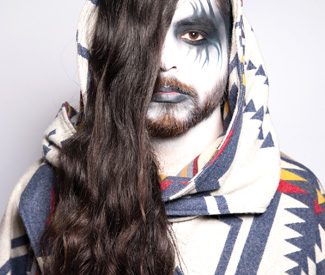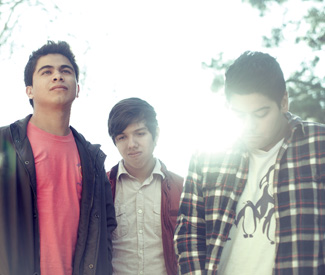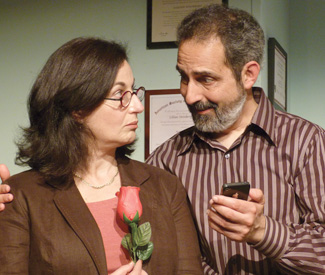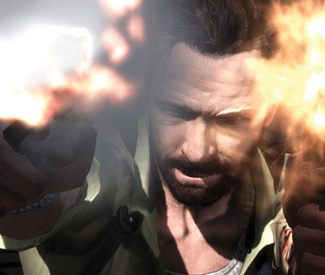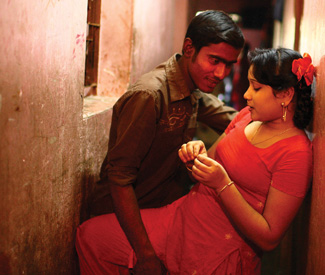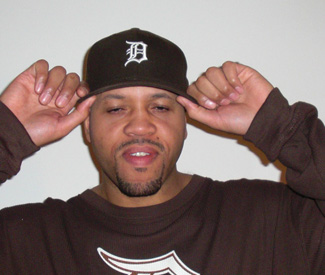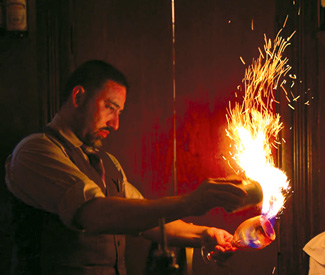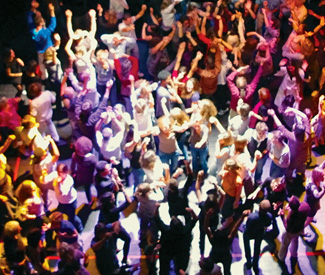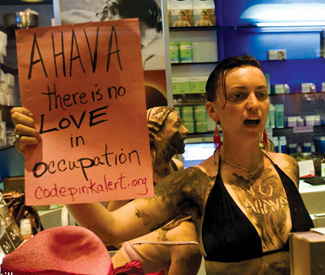emilysavage@sfbg.com
MUSIC Long black hair and ripped jean vests in the crowd, billowy hooded capes on the stage, DJs in jersey tanks and caps, and sea of flickering blue lit cell phones; there’s something spooky happening out there in Club Land, San Francisco. It’s almost as though the dark arts kids have discovered dance music.
Roll your eyes. Of course, that’s reductive. Goths and punks have long been venturing into dance clubs. Acts like Gang of Four, Liquid Liquid, and Siouxsie and the Banshees harnessed the power of beats, shooting rhythm directly into the noise decades ago. And then there was the dance-punk revival of the early 2000s, with LCD Soundsystem and its emblematic label DFA out front, and Black Eyes and Liars leading the weirder charge.
But lately in the city, there seems to be a handful of party curators gaining more recognition for throwing darkly experimental events, lining up unexpected live acts and multifaceted DJs, haunting visuals and thought-provoking participatory art. It’s a mix of live experiments, spooky glitches, punk-rap energy, and a particularly homegrown brand of San Francisco messiness. It’s been referred to as Tumblr culture, a grand, winking, sparkling, blood-soaked mix of references and cultures.
What’s more, these parties provide a space for those previously unassociated with fundamental club culture (i.e. have spent their lives hunkered down in venues and warehouses) with an entry point. Like all scenes, it can be difficult to break out of routine, but it seems almost rudimentary: bringing unconventional live bands to club nights draws in broader crowds.
Kevin Meenan, otherwise known as epicsauce, has witnessed this introduction in the first few months of his budding new party Push the Feeling. While he’s long covered nightlife and hosted live “one foot in the punk world, one foot in the dance world” events, he described this new endeavor as a handholding experience, convincing indie-garage-shoegaze centric friends to come out to a night in the electronic realm.
Maybe the rise of such experimental parties is thanks to the endless digital back catalogue of influences now available at the fingertips; it’s hard to say. But it’s fun and challenging, regardless. So is this the critical blog culture come alive?
SLEEP ONE NIGHT, RAVE THE NEXT
Marco De La Vega, another local figure in this experimental party-thrower culture, thinks so. He uses the same language to describe a recent party he threw, Public Access.
“To a large extent it was almost like a tongue-in-cheek mix-up of that old rave culture and like, the Tumblr culture that kind of exists now,” he explains. “This idea that every single person is, in their own right, constantly exposed and famous, and also in this really creepy, amazing, 10-second flashes of animated GIFs kind of way.”
While De La Vega works on other current monthly and twice-monthly events such as 120 Minutes and Future Perfect, April marked the very first installment of Public Access, which took place at Public Works in the Mission.
It’s a concept De La Vega says he’s been mulling over for years, an eclectic, visually minded show based around people generating their own content. He counted on a crew of some 10 to 20 friends and creative types to help reel in his fantasies, and help turn concepts in realities. In conversation, he repeatedly credits the same loose circle with co-organizing all the events on which he works.
At that first Public Access night, there were video screenings, and performance art, along with “forward-thinking drag queens” Dia Dear and Boy Child. Hype Williams, Gatekeeper, Teengirl Fantasy, and Total Accomplishment performed, as did DJs including frequent collaborator Dial Up, and De La Vega himself— who goes by the name S4NtA_MU3rTE. While very well attended (sold out, in fact) the Public Access night will only happen sporadically — when the exact right lineup can be formed.
120 Minutes (First Fridays, 9pm, $10–$15. Elbo Room, 647 Valencia, SF. www.elbo.com), De La Vega’s longest-running current party has seen darkwave, chopped and screwed hip-hop, and grave rave acts such as Pictureplane, oOoOO, Light Asylum, Cold Cave, White Ring, Salem, and Tragik come through over the past year and a half. Next up, a likely-to-sell out show with field recording wunderkind producer Balam Acab.
Future Perfect (Second and Fourth Thursdays, 10pm, $10–$15, Public Works, 161 Erie, SF. www.publicsf.com), is another consistent party of his; it’s a collaborative effort with veteran rap promoter Gary Rivera (though again, all of De La Vega’s efforts take a village), which began at Monarch but now also takes place at Public Works.
“The idea on [Future Perfect] is similar to everything I work on,” De La Vega says, sucking down a bacon Bloody Mary at Pop’s on a sunny afternoon. “It’s basically the embodiment of this idea that there is such a huge cross-section between various musical genres, and particular production styles of music, so rap, electronic, anything ‘future based,’ he air quotes, “post-dubstep, post-anything. There’s this huge intersection between all these scenes that doesn’t actually have, strangely, its own outlet.”
It’s interesting that De Le Vega even got into throwing parties in the first place, given his back-story. He grew up a self-described record nerd who never went to clubs. He says he’s still not really a fan of clubs, which is hard to believe. “My issue with a lot of club nights is this idea that everything has to be something, or have a label, or be a scene,” he says.
He was raised in both Stockton and upstate New York, went to his first show at age 6 — Beastie Boys and Run-DMC with his two older sisters — and soon fell in love with radio pop (Prince) and gangster rap (Ghetto Boys).
After high school spent mulling around shows with the punk kids, he eventually moved back out west, this time to a loft in SOMA. While he stayed in most nights, his roommate went out and brought the parties back to the loft. This is when, as the drunken masses entered his shared space, a stoned De La Vega would spin his own music.
This lead to friends asking him to DJ their events, and eventually, his first foray into throwing parties: Suicide Club, at the Cat Club in 2003. It had dark vibes, beat-driven music, and a kiddie pool full of fake blood. The point was to pull in aspects of everything De La Vega loved.
“So for me, at the time, and I guess still, it was performance: performance art, music, the hardcore shows, experimental music shows. And the thing I loved but didn’t know what was happening with it, was dance music. I fucking adore dance music.”
The night did well, but De La Vega pulled the plug after eighth months, because of a turn of context. Suddenly, half the club would be filled with “jocks standing around just to watch chicks get naked and roll around in blood.”
While De La Vega stresses that he has no specific messages with his parties, he does believe in context, and he was no longer comfortable with the context in which these parties were playing out. He went back to DJing bars, mixing post-punk and gangster rap, and spending a lot of time freaking people out in pot clubs with five-hour long sets.
120 Minutes at Milk Bar in September of 2010 was his first return to throwing his own parties. The lights-lasers-sounds party quickly outgrew Milk, moved to its more permanent home at the Elbo Room and has remained a wildly popular event there ever since, playing, as oft-noted, mixes of Salem, Waka Flocka Flame, Dragged Out, Skinny Puppy, and Nicki Minaj.
“It’s an insanely amazing time for music. The breadth of widely available, quality work is wider than it has ever been, and this has changed the market drastically in the last decade… hell, in the last few years,” he says.
Adding, “Accessibility has lead to a larger common vernacular for artists to pull from, and in turn to a blurring of genre lines and a more relaxed take on the previously stringent rules that would guide the way a lot of musicians produced music and also how fans would consume it.”
De La Vega still DJs most of his own parties as S4NtA_MU3rTE, and has a mad scientist freedom to explore. He makes video files using the Serato program and uses turntables and vinyl as MIDI controllers, but also uses a program that combines live production program Ableton with Serato. He usually spins his own remixes, including a popular Waka Flocka Flame mix — he says every time he plays someone screams “Play Waka!” That, or Gucci Mane: “Any crowd, doesn’t matter the scene, they always freak out about Gucci Mane.”
Though he also taps into the bleaker stuff. He does all graphic design for the show posters he wheatpastes around the city, most frequently slick black affairs with crystallized white skulls. He agrees he has an overall darker vibe but not necessarily gothic.
“Goth doesn’t mean anything anymore and I feel like it gives the wrong vibe. But to some extent I come from that vibe. To me it implies the wrong things — Frankenstein boots, and multi-colored extensions — and that can be pulled off, it’s just not me.”
He breaks it down in the most understandable of terms toward the end of the warm afternoon at Pop’s: “I want to be able to go and watch [stoner metal act] Sleep one night and then go to a rave the next, and definitely still get backstage for the A$AP Rocky show.”
RIPPING OFF OPTIMO
It was a combination of influences that first got Kevin Meenan, a.k.a. epicsauce, interested in having his own e-list of local shows.
First, he was learning to use open source system Drupal, but more to the point, he found New York web list Oh My Rockness, on which he discovered SF-based act Tussle playing a show when he happened to be visiting a friend in New York.
The biggest inspiration however was long-standing punk and thrash e-list The List. “I have probably looked at it once a week, every week, since eighth grade,” he says. Spare and simple, The List is pretty much exactly what it sounds like, ongoing lists of Bay Area shows. Meenan, who now lives off Divisadero in SF, grew up in the Walnut Creek area, so he’s been going to local shows for quite some time.
He began epicsauce.com in 2007, a few years after he returned to the Bay. He’d gone to college in Boston and spent a year abroad in London, where he discovered club nights he actually wanted to go to. “epicsauce.com was supposed to be like The List,” he later adds, “but a little bit more inclusive of dance music and stuff I was just starting to get into it at that point.”
Now, five years and many remixes later, Meenan throws a free dance music-oriented party, Push the Feeling (Monthly, dates vary, 9pm, free with Facebook RSVP. Underground SF, 424 Haight, SF.), with high school BFF/roommate Andrew Marcogliese, a.k.a. YR SKULL. The Lower Haight event has thus far featured Magic Touch, Shock, Chucha Santamaria y Usted, and shortcircles, among other acts.
“I can safely say that there’s this [legendary ’90s-born party] in Scotland, that I’ve never been to called Optimo, and this is 100 percent me trying to rip off Optimo,” he says with an easy laugh. “In my mind they have the coolest shit, cross genres.”
Meenan also leans heavy on newish label 100% Silk, which describes itself as making “singles of diamond-life dance & bliss-disco & basement luxury grooves by friends and lovers from all over the world.”
He says the label has been pretty central to him exploring older house music.
Push the Feeling is shiny and new, and still figuring out its place, but it’s an interesting evolution for Meenan. “This is my first attempt at trying to do more traditional nights,” he says. With that said, the shows do have still have exuberant punk-energy of live music along with exciting DJs.
A DJ now himself, using Ableton Live, he’s been enjoying playing ’70s disco songs, then ’90s house covers and watching the crowd, or spinning Peech Boys’s ’81 track “Don’t Make Me Wait” followed by the ’87 remix “Don’t Make Me Jack” by Paris Grey. With those mentioned, he sings a few strains of each. “That’s one of the things that has really attracted me to dance music, you can cover 30 years of music history within a 20 minute period.”
While Push the Feeling may be one step in a particular, bass-heavy direction, it’s not like this is entirely foreign to Meenan. While he was doing the epicsauce.com list, which led to writing band profiles on SFist and other freelance writing work, he also was throwing his own near-weekly epicsauce.com presents parties at Milk.
The first show he ever did, February of 2009, included French Miami and Silian Rail. From there he booked a Neon Indian DJ set, Boys IV Men, Baths, Yacht — nearly all acts with some sort of electronic element, synth, or just straight up DJs.
After years spent tiptoeing the line between rock and electro, Meenan is very aware of the backlash against so-called “hipster house” — this calling out of relatively new bands and producers coming out of rock scenes, hinting at not fully appreciating the decades of dance music references that came before them.
He says he hopes he’s turned the page on that, as an obsessive music collector who spends weeks at a time studying one producer then said producer’s influences, but he also calls out the backlash as the prototypical hipper-than-thou refrain.
“I think there’s some validity to it, yeah there’s a lot of cool stuff that came before this, but I think it’s no different than the old man indie argument. This has been going on forever. I think this is true with any genre, and any form of music ever.”
SYNTH AS THE COMMON THREAD
Let’s get this out of the way, C.L.A.W.S. stands for “Can’t Live Anywhere Without Sandwiches.” Brian Hock says this with a small, proud smile from a tiny table in the Dogpatch Saloon.
It’s Hock’s minimalist, synth-driven solo project he’s been making music for since 2007. He’s also currently helping produce tracks for Group Rhoda, drumming for Bronze, and booking monthly experimental dance club-meets-live music night O.K. Hole (Third Saturdays, 9pm, $5. Amnesia, 853 Valencia, SF. www.amnesiathebar.com) at Amnesia.
The roster of acts that have played O.K. Hole in the past three years — the night began in 2009 — is impressive, if not wholly representative of this modern post-everything genre blurring. Of course Bronze and C.L.A.W.S have stopped in, but also Eats Tapes, Jonas Reinhardt, Magic Touch, Coconut, Royal Baths, Late Young, Soft Metals, Silk Flowers, Water Borders, and dozens more. They book live electronics, coldwave, techno, and synth-y house, Hock says. Synths are the common thread between most of the acts, he adds.
Hock has been a part of the Bay Area music scene for some 20 years, in various forms, and agrees that O.K. Hole is something of an amalgamation of his past two decades, all funneled into one party. Well, maybe not his first band.
He played in a crappy punk band at age 14 in San Mateo, hung out at the Gillman and listened to a lot of grindcore — Man is the Bastard, Spazz. He then moved on to playing in a synth-based heavy psychedelic act, followed by a dark new wave band called the Knives.
From the ashes of the Knives, rose the goth-y metal band the Vanishing, likely his best-known band from that mid-Aughts era. He and fellow member Jessie Evans moved to Berlin and toured Europe. This is when he also began focusing on DJing. “It made me a total techno asshole,” Hock laughs.
After the Vanishing broke up after a show in Vienna, Hock moved back to the states, to a warehouse on Third Street in the Dogpatch. It was there where he threw all-night, underground jams called Gentlemen’s Techno, which he describes as similar to O.K. Hole but more dancefloor-oriented. “It was the crappiest, jankiest sound system ever, like 14 different speakers thrown together on top of these like six-foot tall motor-driven subs that used to be Def Leppard’s.”
After Gentleman’s Techno was kaput, Hock started O.K. Hole, only it was a DJ night at Argus Lounge with a friend who soon left the Bay Area. Once she moved, O.K. Hole moved to Amnesia and began as a regular monthly with the help of Rob Spector also of Bronze, and Nathan Burazer from Tussle. The night typically hosts two to three live acts, and then DJs. “We just wanted to have a place to book friends, and stuff we like,” says Hock. “It’s not a money thing.”
Hock himself DJs the nights on two turntables, usually playing mixes of house and techno. The now-Oakland based musician-promoter has also been recently discovering newer parties in the East Bay — a techno party called Direct to Earth, and the abundance of underground punk and hardcore shows. He’s been around the block and back around again.
“[The Bay Area musical landscape] is always changing,” he notes. “There have been a lot of really fun eras here that are all completely different. A movement will come together, and there will be something around it for two to four year cycles, and then that’ll dissipate.”
Perhaps it really is all just fleeting. It’s better to dance tonight, and worry tomorrow about all that heady place-in-history stuff. Or maybe it’s worth taking a second look.
“Sometimes I feel like it’s just all seems so confusing — what is this? All this stuff I’m so obsessed with?” Hock asks with a sigh when his music history is noted. “But then it coalesces and it’s like yeah, I really love this.”

